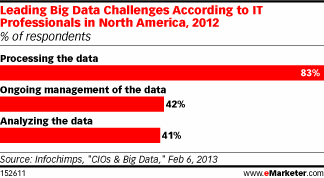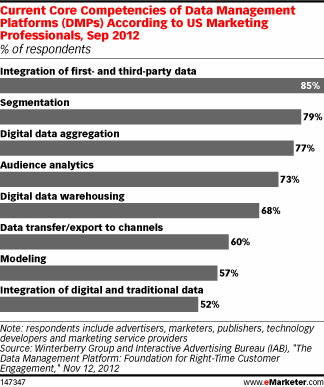 京公网安备 11010802034615号
经营许可证编号:京B2-20210330
京公网安备 11010802034615号
经营许可证编号:京B2-20210330
大数据与数字化营销
【大数据与数字化营销】据对美公司首席信息官(CIO)的调查发现:仅23%的公司在收集顾客的人口信息和消费习惯之类的数据,并且利用这些数据进行战略决策。但其中却仅有46%的公司拥有数据分析的资源或系统。他们面对的主要挑战在于数据处理、信息管理和数据分析难题。数据管理平台(DMP)发展空间巨大,将是未来数字营销的理想工具。
文章全文:
To Handle Big Data, Advertisers Turn to DMPs
There’s a big to-do about Big Data and data management platforms (DMPs) in the digital advertising space. According to a new eMarketer report, “Data Management Platforms: Using Big Data to Power Marketing Performance,” DMPs enable marketers to use their Big Data to make smarter and more efficient marketing decisions.
Still even as brands use Big Data to build a holistic picture of their potential and real customers, many still find it challenging to extract cross-channel insight from that data.
Ziff Davis found 49% of companies polled worldwide had enacted a data management strategy as of fall 2012. And according to a survey from IT staffing service Robert Half Technology, just 23% of US chief information officers (CIOs) said they were collecting customer data such as demographic information or buying habits. Of that small percentage, less than half (46%) reported having the resources or systems to analyze the information they gathered.

A very general term, Big Data can refer to first-party customer information, third-party audience data, offline purchase data, online advertising behavioral data, campaign analytics and much more.
It can prove challenging to integrate disparate sets of data coming from social media, campaign analytics, offline sources or third parties. In fact, Big Data solution provider Infochimps surveyed IT professionals in North America and found that 83% of respondents said processing such information was a leading Big Data challenge, followed by managing the information (42%) and analyzing the data (41%).

If data is digital marketing’s currency, then the DMP is its bank. Big Data is stored and standardized here so that each data asset can be tied to a particular customer or audience segment. Once standardized, marketers can use that information to power multiple functions, both within digital and across a company’s broader marketing program.
DMPs can house both structured data, typically quantitative in nature, as well as unstructured data, often qualitative in nature—for example, social network data. Once all of these disparate sources are entered, DMPs can standardize them to build a larger, more descriptive picture of a customer or audience base that marketers can act on.
The DMP’s ability to take all of that Big Data from first-, second- and third-party sources and then organize it into meaningful audience segments makes it an ideal tool for audience targeting. This function—particularly for first- and third-party data—was also the top-reported competency of DMPs by US marketing professionals in a September 2012 surveyed by Winterberry Group.

Other than their role in organizing data on customers, DMPs are also a prime tool for campaign measurement, both within digital and across platforms.
“There’s real value in being able to address the audience first to determine what to buy,” said Mark Zagorski, CEO of data provider eXelate. “By looking at your audience and how they’re interacting with a particular ad or promotion, you can take those learnings and feed them into your current efforts and your next campaign.”
The full report, “Data Management Platforms: Using Big Data to Power Marketing Performance” also answers these key questions:

数据分析咨询请扫描二维码
若不方便扫码,搜微信号:CDAshujufenxi
CDA中国官网是全国统一的数据分析师认证报名网站,由认证考试委员会与持证人会员、企业会员以及行业知名第三方机构共同合作,致 ...
2025-12-26在数字化转型浪潮下,审计行业正经历从“传统手工审计”向“大数据智能审计”的深刻变革。教育部发布的《大数据与审计专业教学标 ...
2025-12-26统计学作为数学的重要分支,是连接数据与决策的桥梁。随着数据规模的爆炸式增长和复杂问题的涌现,传统统计方法已难以应对高维、 ...
2025-12-26数字化浪潮席卷全球,数据已成为企业核心生产要素,“用数据说话、用数据决策”成为企业生存与发展的核心逻辑。在这一背景下,CD ...
2025-12-26箱线图(Box Plot)作为数据分布可视化的核心工具,凭借简洁的结构直观呈现数据的中位数、四分位数、异常值等关键信息,广泛应用 ...
2025-12-25在数据驱动决策的时代,基于历史数据进行精准预测已成为企业核心需求——无论是预测未来销售额、客户流失概率,还是产品需求趋势 ...
2025-12-25在数据驱动业务的实践中,CDA(Certified Data Analyst)数据分析师的核心工作,本质上是通过“指标”这一数据语言,解读业务现 ...
2025-12-25在金融行业的数字化转型进程中,SQL作为数据处理与分析的核心工具,贯穿于零售银行、证券交易、保险理赔、支付结算等全业务链条 ...
2025-12-24在数据分析领域,假设检验是验证“数据差异是否显著”的核心工具,而独立样本t检验与卡方检验则是其中最常用的两种方法。很多初 ...
2025-12-24在企业数字化转型的深水区,数据已成为核心生产要素,而“让数据可用、好用”则是挖掘数据价值的前提。对CDA(Certified Data An ...
2025-12-24数据分析师认证考试全面升级后,除了考试场次和报名时间,小伙伴们最关心的就是报名费了,报 ...
2025-12-23在Power BI数据可视化分析中,矩阵是多维度数据汇总的核心工具,而“动态计算平均值”则是矩阵分析的高频需求——无论是按类别计 ...
2025-12-23在SQL数据分析场景中,“日期转期间”是高频核心需求——无论是按日、周、月、季度还是年度统计数据,都需要将原始的日期/时间字 ...
2025-12-23在数据驱动决策的浪潮中,CDA(Certified Data Analyst)数据分析师的核心价值,早已超越“整理数据、输出报表”的基础层面,转 ...
2025-12-23在使用Excel数据透视表进行数据分析时,我们常需要在透视表旁添加备注列,用于标注数据背景、异常说明、业务解读等关键信息。但 ...
2025-12-22在MySQL数据库的性能优化体系中,索引是提升查询效率的“核心武器”——一个合理的索引能将百万级数据的查询耗时从秒级压缩至毫 ...
2025-12-22在数据量爆炸式增长的数字化时代,企业数据呈现“来源杂、格式多、价值不均”的特点,不少CDA(Certified Data Analyst)数据分 ...
2025-12-22在企业数据化运营体系中,同比、环比分析是洞察业务趋势、评估运营效果的核心手段。同比(与上年同期对比)可消除季节性波动影响 ...
2025-12-19在数字化时代,用户已成为企业竞争的核心资产,而“理解用户”则是激活这一资产的关键。用户行为分析系统(User Behavior Analys ...
2025-12-19在数字化转型的深水区,企业对数据价值的挖掘不再局限于零散的分析项目,而是转向“体系化运营”——数据治理体系作为保障数据全 ...
2025-12-19